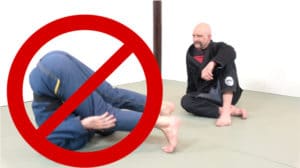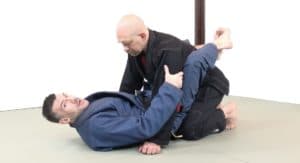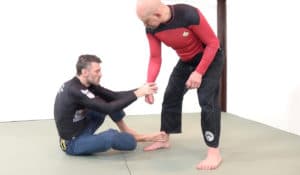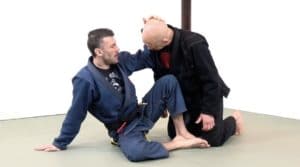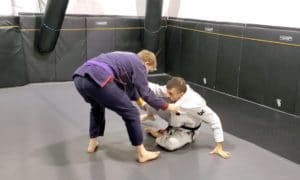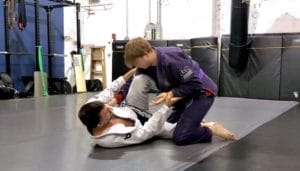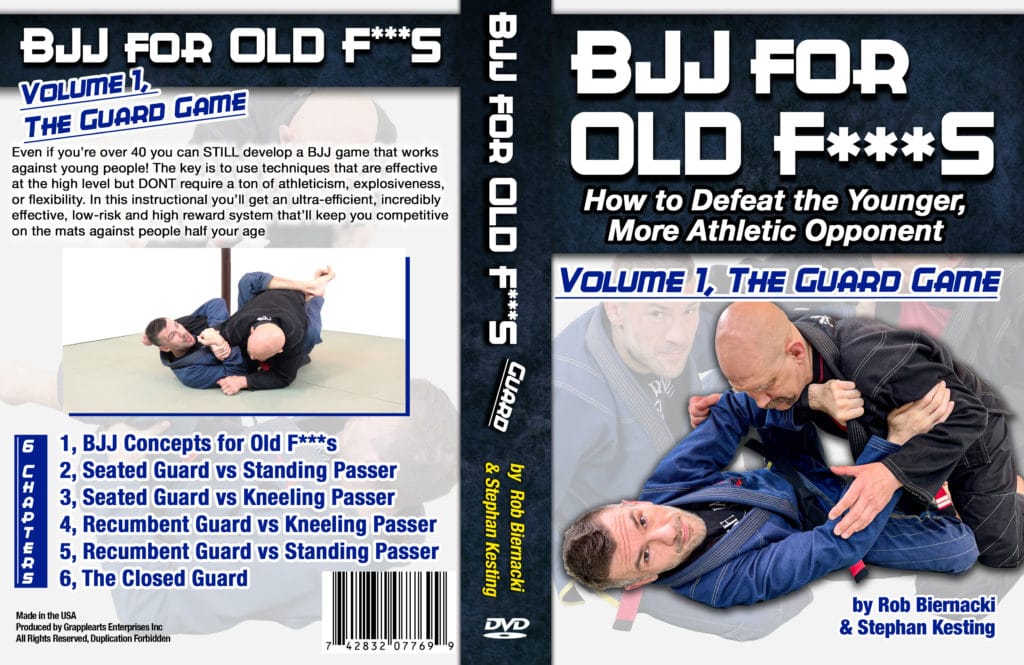Rob Biernacki and I have just released BJJ for Old F***s, and from that instructional here are some of the most important tips for the older grappler.
Specifically in this episode Rob Biernacki (age 46) and I (age 52) discuss…
- The two things that change most about your training as you get older
- How to improve as fast as possible by limiting your training
- Why base, posture and structure are even more important for older grapplers
- How to select for techniques that are high percentage at the high level but still work on young whippersnappers
- Exactly how to stay safe on the mat and not get injured
- Reducing unnecessary movement so you don’t get tired
- How gripfighting and range management will dramatically improve your abilities on the mat
- And much more.
Honestly, if you’re beginning to creep up on the wrong side of 40 then this is a must-watch, must-listen, or must-read.
Key Tips and Strategies for Older Grapplers (Video Format)
Here’s the video version of the podcast…
Key Tips and Strategies for Older Grapplers (Audio Format)
This video was also published as episode 363 of The Strenuous Life Podcast. You can also listen to the audio-only format of the episode on your podcast player.
It’s on all major podcast platforms, but here are some of the major links to get you started…
- Apple Podcasts
- Google Podcasts
- Spotify Podcasts
- Stitcher,
- And most other podcast players
Or if you want to stay on this page please use the embedded audio player below…
Key Tips and Strategies for Older Grapplers (Highlights)
Learning BJJ is hard enough, but older grapplers have it even harder!
You’re trying to keep up with the young studs who do nothing but train all day, but your body keeps letting you down.
Snap, crackle, and pop isn’t just for breakfast cereals anymore – it’s your joints.
Even the older, more experienced belts feel the same way. There are lots of purple and brown belts who feel a pang of anxiety when that young, athletic blue belt comes up and asks them to roll.
But age is what it is. It”s not your fault that you started training later. It’s just that as an older guy you need to train and perform jiu-jitsu somewhat differently.
Here are 6 key tips to keep you safe, make progress, and hand those young whippersnappers their comeuppance…
1, CHOOSE YOUR TECHNIQUES CAREFULLY
As an older grappler you just can’t use techniques that rely on athleticism, flexibility, or scrambling.
You can’t do techniques that require you to contort your body into a pretzel. You can’t maintain the pace required to ‘wrestle up’, scramble or explode into submissions.
Pretending you’re a bendy 20 year old will only result in a loud ‘POP!’ sound, agonising pain, and never ending parade of visits to your doctor, chiropractor and physiotherapist.
Instead you need a game that works for older body types. What you’re looking for are techniques that are effective at high levels of competition, but DON’T require a ton of athleticism, explosiveness, or flexibility.
The techniques with the highest return on investment are the ones where you use leverage to manipulate your opponent however you want.
Look to use leverage instead of strength, muscle or flexibility wherever you can.
2, RECONSIDER YOUR GUARD GAME
Maybe nothing changes for the older grappler more than how they use the guard.
A young punk can afford to lie on his back, let his opponent get grips, then spin, invert, and high leg to his heart’s content. He can twist into sweeps and contort into submissions.
If you try that same approach excuse my French you’re f***ed!
After age 40 not all guards are created equal. You need to become much more picky about which types of guard you’re going to play.
Forget about rubber guard, spider guard, inverted guard, reverse de la Riva guard and most of the modern guards.
Next you need to pick the right techniques from your guard. Obviously the attacks that require a ton of flexibility have to be kicked to the curb. Also ditch those inverting attacks and explosive moves.
Finally consider the downside of every attack. What can go wrong with them and can you get injured if that happens?
For example, what if some young guy hulks his way out of a submission, maybe by rolling you up onto your head? Getting stacked like that has herniated more than one disk in more than one friend of mine.
Fortunately you can definitely still have a very effective guard even as you get older.
The key is to use techniques, positions and strategies that slow the other guy down…
3, SLOW THOSE YOUNG PUNKS DOWN
As an older grappler you don’t have a bottomless gas tank anymore. But those young guys by contrast are like the Energizer bunny – they keep going and going and going…
While you might be able to match a young guy move for move for a little while, inevitably this strategy ends up failing in the long run.
Fighting like this drains your gas tank. You’re going to get tired and he’s going to smash you, simple as that!
So what’s a good strategy against those young punks?
For the guard the first step is to win a dominant grip. He who wins the grip usually wins the next exchange, but at the very least a good grip means that the other guy isn’t likely to pass your guard or snap on a submission.
From your grip you then need to win meaningful control over his body.
By limiting the other guy’s movement you now don’t have to deal with a whirling dervish anymore, and your chances of getting injured just went down significantly.
From that control position you can now begin to off balance him, set traps, use old guy patience, and lure him in to his doom.
Finding ways to control the match as a cunning older grappler is much better than trying to match the pace of some young stud.
4, GUARD RETENTION CHANGES AS YOU GET OLDER
Guard retention is your ability to keep your opponent safely in your guard and shut down his guard pass.
This is an essential skill in BJJ because you can’t win a fight from the guard if the other guy has already blown past it!
Younger jiu-jitsu players often rely on their extreme flexibility to stop the guard pass. They’ll spin into inversions, retract their knees into their armpits, or fold in half with their feet beside their own ears.
Another young guy style of guard retention that you shouldn’t use is based on strength, timing, and explosiveness.
People who use this strategy usually try to ‘wrestle up’ against a guard pass, grind their way up back to their feet, fight for a single leg or a double leg position, and then scramble to finish the takedown in a wild free-for-all.
Both of these are fine strategies for the youthful athlete, but become much more dangerous as you get older; you’re guaranteed to get injured.
Reduced flexibility, a more breakable body, slowed reaction times, and less cardio make injury much more likely if you try to use these ‘young guy’ guard retention strategies.
As an older grappler you need to throw out those guard retention techniques and work smarter, not harder. You need to develop a new toolbox of techniques and strategies that are safe and work for any body type.
The big game changer here is the intelligent use of frames.
Block his forward progress with your bones rather than your muscles, and transfer that force into the floor rather than into you. Then, protected by your frames you can easily re-adjust your hips and legs to unwind his guard pass and get back to your own attacks.
A solid frame is worth its weight in gold, and multiple overlapping frames make your guard damn near unpassable.
5, COMPENSATING FOR SLOWER REFLEXES WITH SNEAKINESS
There’s no sugar-coating it: your reflexes get slower as you get older.
Sometimes this is because our brains ossify as we get older, but it could also be because we don’t have the time to spend all day on the mat anymore.
The best way to look like you’ve got god-tier timing in BJJ isn’t by getting faster! Instead it’s to set up a situation where you funnel the other guy into a position where he’s only got a small set of possible options.
That small set of options means that you can already have a pre-planned response for everything he’s likely to do. Now you’re just waiting for his reaction and can totally beat him to the punch.
Knowing what his response is going to be in advance beats having fast reflexes!
6, MAXIMISE YOUR TRAINING AND DON’T GET INJURED
As you get older you can’t recover as fast anymore, and you’ve also probably got less time you can devote to training.Because of that it becomes incredibly important to train as efficiently as possible.
Your time is limited, so you want train smarter and maximise your results to improve as much as possible within a given amount of time.
For the older grappler the answer is NOT to put in countless hours of sparring and grind yourself into oblivion while hoping that you’ll somehow get better.
You do need to train hard there’s no way around that but instead of trying to develop everything all at once you want to structure your training so that it develops specific skill sets.
And if you can develop those skill sets in a safe manner, without getting injured, then so much the better!
The best way to get good quickly is by introducing limitations to your sparring.
For example you might want to do rounds in which one player is in seated guard and the other is standing. The top player has to stay on his feet, has to approach, and is allowed to do light gripfighting but is NOT allowed to pass the guard
The bottom player by contrast can work on anything: offbalancing, sweeps, submissions, you name it! Then at the end of the round you change positions.
Training like this allows the bottom player the opportunity to refine skills and techniques they’ve learned in a relatively safe environment. It also means that he’s not going to play guard for 10 seconds, get his guard passed, and then spend the rest of the round getting crushed on the bottom.
There are many forms of constrained and situational sparring to refine specific strategies and as you get older you should use them all!
Jiu-Jitsu Techniques, Strategies and Training Methods for Older Grapplers
The latest Grapplearts instructional – BJJ for Old F***s – has a TON of solutions for older grapplers, including…
- How to establish control over an younger guy trying to sprint, dance and dive around your guard
- Strategies to beat faster opponents by setting them up so you can predict exactly what they’re going to do… and then beat them to it
- An extensive, very efficient, but low-energy guard retention system (in Volume 3)
- The exact training methods and drills you can do that’ll allow you to get better as fast as possible, with a much lower chance of injury
- Sweeps that are very high percentage but require almost no athleticism
- Submissions that’ll tap out the young studs but won’t put you in a compromising position if everything goes wrong
- And a ton of other techniques and strategies learned from decades of hard-won experience on the mats. We’ve suffered and broken ourselves so that you don’t have to!
Check out the brand new Grapplearts instructional BJJ for Old F***s. I will say without reservation that it’s really good and will definitely improve your effectiveness and longevity on the mats if you’re age 40 or older!
Stephan Kesting
The post Key Tips and Strategies for Older Grapplers appeared first on Grapplearts.

